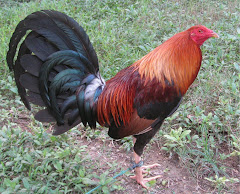
This study was made between December 2004 and March 2005.It was published in sabong.net on April 24, 2005. It triggered a very interesting discussion. The post itself was translated in Spanish and publish in Spanish gamefowl literature.
April 24th, 2005, 10:34 AM #1
rbsugbo
Posts: n/a
Posts: n/a
vCash:
Experiment confirms cocks have natural bio rhythmIf left alone, under normal conditions, gamefowl have natural bio rhythm that guides their individual fighting performances.
This was recently confirmed by an experiment we have conducted.
For three months, from December to early March, this year, RB Sugbo Gamefowl Technology conducted a study involving 20 fowl picked at random.
They were of different bloodlines and crosses and some were bullstags others were cocks.
The birds were sparred every four days and their respective performances were charted.
After 24 sparring sessions the chart showed a clear correlation between the performance of certain birds with that of the lunar cycle.
It showed that fowls' performances are guided by a cycle of four phases consisting of 7 days each.
Coincidence or whatever, the lunar cycle is also of 4 phases of 7 days each.
However, contrary to superstitious belief, there was no correlation between particular plumage or leg color with any particular phase of the lunar cycle.
For example some yellow legged fowl fought well on first quarters while others fought well during other phases of the moon. This was also true to the green leggeds, the greys and the black plumage.
Subsequent experiments have been or will be conducted to establish the extent of the moon's influence on gamebirds and whether this natural bio rhythm could be altered to enable us to time the best performance for a scheduled day of fight.
RB Sugbo Gamefowl Technology breeds and sells fowl. It is also actively into gamefowl research and study in search for new technology especially in the field of game fowl conditioning and pointing.
It has its main gamefowl farms in Carmen, Bohol and Argao, Cebu; a seed fowl breeding station in Naga, Cebu and its conditioning camp in Casili Hills, Mandaue city, all in the Philippines.
Further discussions:
Reply With Quote
rbsugbo
Old April 26th, 2005, 09:31 AM #2
ariel.aquino
Member
ariel.aquino's Avatar
Join Date: Jan 2003
Location: Tarlac City
Posts: 395
Posts: 395
vCash: 500
thnks
Hello sir Rey...i want to congratulate you for you efforts and interesting topic...I am interested on your research on Lunar cycles affecting our fowls performance..please elaborate more on how it was recorded or how it was studied and concluded...I want to understand the 7 phases...please elaborate more if its ok with you sir...for us in this site to give our comments...tnx alot.
goodluck to your research and breeding
Old April 26th, 2005, 10:14 AM #3
roland_kent
Senior Member
rbsugbo
Sir,
i want to know if your study, research, experiment conducted is already conducted by others or your the only first to do this?
it is very appreciated to me, to us, to know this.,
that every fowl has its own bio rythm towards the lunar in their performance in figthing?
this is very helpful to us know..
like i've said, and ariel say..me too i am interested to know,
what is the 4 phases of 7 days each..if it is okay to you? can you shared to us what is that? or please kindly PM to me hehehe
respectfully,
roland
Ariel, Roland,
Thanks. Of course I welcome comments.
My experiment tend to show that individual cocks have individual biorhythm, regardless of plumage and leg color. It did not support the theory or superstition that a certain leg color will perform best on a certain phase of the lunar cycle.
The lunar cycle are the new moon, 1st quarter, full moon, and last quarter.
My experiment showed that 13 of the 20 cocks, or 65% regardless of plumage and leg color and regardless of the phase of the moon, experienced a rising performance for a period of two weeks and then a falling performance in the next two weeks. Four showed erratic chart in their performance. And only three or 15% consistently perform well throughout the 24 sparring sessions, with only slight variations in their performance which could be attributted to factors other than biorhythm.
The methodology was simple. We picked 20 fowl of different crosses and ages. All however, were in good physical conditions.
They were first subjected to metabolism check to determine which ones have high metabolic rate and which ones have low metabolism.
This is important in order to adjust their respective diets, because the work out routine of all the birds were the same. Just our plain rotation method. otherwise if given uniform diet, the ones with low metabolic rate would tend to get heavier and it might be a factor in the performance registry.
Then we sparred them every 4 days and recorded their respective performance.
Roland, as to your question whether this has been conducted by others, I really would not know. However, for sure, the cockers of the old times had observed this, even without the benefit of a formal experiment because i heard my grandfather before saying that on this particular Sunday this cock was unbeatable.
Reply With Quote
rbsugbo
Old April 26th, 2005, 03:11 PM #5
jbermudes
Someone asked whether a similar study has been done and the answer is, "yes". A friend of mine showed me a chart of the lunar cycle and its relation to the feather and leg color of the rooster. The chart was copied out of the encyclopedia. As such, someone did some sort of controlled study similar to the one presented here.
I am a beginner and I hear different responses to the following questions:
1. How many times should you feed the gamecocks?
2. Does overnight lighting help the cocks? Will this affect their sleep and rest time?
3. Does one need to provide a noise medium to make the cocks assimilate to the noise in the arena?
I would love to hear from anyone.
Joe
Reply With Quote
jbermudes
Old April 28th, 2005, 11:06 AM #6
rbsugbo
Jbermudes,
1. The usual practice is two. plus snack at noon if you may. That is what we also do for the cocks we sell. It is different for the cocks that we ourselves fight.
2.Yes. Somehow light has some effect on the hormones of the chickens. Layers need more daylight to lay more eggs. The light on gamecocks is more than training them to be used to lights at the pit. Longer daylight has positive effect on fighting cocks conditioned for fight. But up to a certain limit. Overnight light is not advisable.
3. Many do. But it is really useless at the very least, and possibly even harmful. Well, that was what our experiments on stress management showed.
Reply With Quote
rbsugbo
Old April 28th, 2005, 05:13 PM #7
swallow
Senior Member
swallow's Avatar
rbsugbo,
very nice topic you open up here.
To be honest with you this is my observation with gamebirds, whether you train them or not, or do some pointing for as long as you provide proper nutrition and feed properly you will observe that birds will achieve peak health by itself. hence if you are the type of cocker that fights in hacks, then your function is to observe, which birds are peaking up. You will observe their movements as spanking and they fly up and down the teepee every now and then.
The problem is when your join derbies and you want all your birds to move at the same level come fight day, then that is where conditioning aids and preparations come into the picture.
Swallow
rbsugbo
Swallow,
Yes. You are right. Old time cockers made a killing by just observing the natural peaking of their birds.
And, as far as derbies are concerned, we always pick the cocks that we believe will perform best on the scheduled day of fight based on their chart.
Also we will try to do something to increase the probability of their performing well, by what we call as "zeroing their energy."
In theory based on the experiment it is supposed to be simple. All we have to do is put the cock at the lowest energy level some 14 days or two weeks before the fight. Then it is supposed to fight best on fight day.
In practice thought, you have to contend with the cocks' individual capability to cope with the initial stress as result of putting them at low energy level.
We solved this problem by conditioning more cocks than necessary to give allowance to this factor.
The bottom line still is the quality of the cocks. yet, it pays to pay attention to conditioning details.
Regards,
Reply With Quote
rbsugbo
Old May 7th, 2005, 02:37 PM #9
rbsugbo
UPDATE :
We are planning to repeat the experiment. This time using the stags that we are going to fight come the stag season.
And to ensure a more conclusive result, we will increase the sampling from 20 to 50 heads.
Reply With Quote
rbsugbo
Old May 7th, 2005, 08:08 PM #10
buhawi
very interesting topic
Reply With Quote
buhawi
Old May 9th, 2005, 11:08 AM #11
el_guapito
Talking just a reader!!!
nice topic!!!
Reply With Quote
el_guapito
Old May 9th, 2005, 12:54 PM #12
gamecock96
CyberFriends
gamecock96's Avatar
Do we have to conclude that when you choose birds for a derby and you use a 21 day keep or something close to it. That you should choose the reg. sparrers at the start of the keep and expect that they would peak at fight day??? Cause if we choose good sparrers already which are cocks or stags that are already at its peak, they might start going down to fight day??
Al
#13
rbsugbo
Gamecock 96,
Yes. Something like that Al.
In fact that is our purpose of putting the cock at low energy level at the start of the keep. In this manner the cock is expected to gradually peak in time for the fight.
And, you can only keep a cock at its peak for a certain period. After this there will be no other way for it to go but down. This stage is called "over the hill."
Regards,
Buhawi, El Guapito,
Thanks for your interest in this topic.
Reply With Quote
rbsugbo
Old May 10th, 2005, 07:08 PM #14
gamecock96
CyberFriends
g
Thanks Rey,
Im also interested on how your study progresses. Pls keep us all updated.
Al
Old May 12th, 2005, 12:56 AM #15
rbsugbo
Al,
Yes, I will keep you and everybody else posted.
Reply With Quote
rbsugbo
Old May 12th, 2005, 01:18 AM #16
doongan
very interesting topic Rey.i'm just wondering,you mentioned you sparred the fowls every 4 days,could it be that they were soar that's why their performances declined?i noticed that too with some fowls.when you pick and spar a rooster from a cord given he was left there for quite sometime he delivers crisp strong blows.then you put him on a keep that requires training and after a week or two when sparred again his performance deteriorates.but given enough time to rest he comes back fighting good.some fowls do good when worked hard and some are just better to be left alone.
Reply With Quote
doongan
Old May 12th, 2005, 12:04 PM #17
sugbo_slashers
Senior Member
ive done this before on a much smaller scale...i tested using a cock at a time...i sparred every Sunday...
my degree of error is greater than RBSUGBO because I held every 7th day (Sunday) constant
i held Sunday constant thinking that there must be a particular Sunday where the cock will perform much better than during other Sundays.
i used a total of 3 cocks...2 wins 1 loss using this method...
1 cock has a peak Sunday cycle of 3 weeks...one had 4 weeks...the third sparred well every Sunday...
the one with the 4 weeks cycle lost his match during the drag..
test duration: 3 months
Reply With Quote
sugbo_slashers
Very informative . . . I like this thread
Reply With Quote
juggernaut
Old May 15th, 2005, 12:05 PM #19
rbsugbo
Doongan,
We sparred the cocks every four days in order for us to observe any change in the cock's performance within a week's time. If we sparred them every week instead, there was this possibility that we could "skip a phase.' Meaning there might be some data in the cock's performance that we could not register in the chart. I think, this point was recognized by Sugbo slasher in his post saying that his " degree of error is greater than RB Sugbo's because I held (sparring) every 7 days."
Also our sparring sessions were short. In fact when we condition cocks for fighting, there is a phase during which, we spar them almost every day.
To us, proper sparring is good training. Sparring is the only exercise that approximates actual combat. But of course, one has to do it properly.
Sugbo slasher,
Although as you said your experiment was on a lesser scale, the result was more or less the same.
Thanks, for the additional data bai.
Reply With Quote
rbsugbo
Old May 16th, 2005, 03:06 AM #20
Budoy2
Member
Low energy
How do you put a fighting cock on "low energy" level. I saw cocks that are on high energy level for a long time, but come showtime they just short of saying just gave their fight away. They don't perform as well when they were in sparring session...
The best thread of thought on this column... thank you all for the never selfish comments... Let's keep the Philippine Sabong the best in the world forever.....
Budoy2 is offline Reply With Quote
Budoy2
Old May 17th, 2005, 01:01 AM #21
doongan
rey, i'm just curios.most of the cocks fought well the first 2 weeks and started falling down the next two weeks.were they able to come back to their peak after that?and what could have happen if you set aside one group of cocks(group B)and spar them once the other group(group A) starts to deteriorate.do you think group B would outperform group A?or would they lose their peak too gven they were not sparred the first two weeks like group A?your inputs are highly appreciated rey as i find this very interesting to increase our W's.thanks.
Reply With Quote
doongan
Old May 17th, 2005, 04:04 AM #22
buhawi
temperature in and out and humidity rate play important role and affect their rate of metabolism.it will affect the way they rest and the way they load energy.
patrick antonio mentioned once the method of conditioning using aircon.they say they are hard to beat.why?
see above:lol: or none of the above:lol:
Reply With Quote
buhawi
Old May 17th, 2005, 05:46 PM #23
rbsugbo
Budoy,
Our method of putting cocks at low energy is a combination of heavy workout, fasting, deworming and delousing.
The idea is to put the cocks at low energy so they have no other way to go, but up as we get closer to fight day.
Doongan,
Yes, the cocks concerned started peaking again after the down phase. It was like a cycle of 14 days down phase and 14 days up phase.
Buhawi,
If PA said cocks in airconditioned cockhouses are hard to beat, the most obvious reason may be, because under controlled environment the birds are not subjected to stress caused by changes in temperature and humidity. There may be other reasons too that have something to do with the cocks proper metabolism and right body temperature.
However, aircon technology is very tricky. For one air conditioner is dehumidifier. Your birds tend to get over dry. there are also other pitfalls such as the difference between the inside and outside temperature and humidity.
Reply With Quote
rbsugbo
Old May 17th, 2005, 06:48 PM #24
Dulag
Junior Member
rbsugbo,
sir what is faulty about air conditioner as a dehumidifier? isn't it that we want our cocks to be less dry come fight day? of course we cannot let our fighters to go over dry, that is why we limber tham so they can drink from time to time. my point is airconditioner may be a good solution for us to have a better control to our cock's moiisture body content come fight hour..
Dulag is offline Reply With Quote
Dulag
Old May 17th, 2005, 08:24 PM #25
sugbo_slashers
Senior Member
sugbo_slashers's Avatar
a dehumidifier removes moisture from the air by cooling the moisture and condensing it.
i think that preparation must involve taking the temperature of the pit to adjust the moisture control of the fowl. if air-conditioned fowls are fought on a pit whose temperature is higher, the natural reaction is to sweat..no problem. but since the temperature change is abrupt, the sweating will be accelerated too to compensate...now this is where the problems start...
it just a matter of acclimization...it should not be done abruptly
but if the airconditioned room's temperature/humidity is the same as the pit...oh well...when the scabbard drops..the BS ends...hehehe
sugbo_slashers is offline Reply With Quote
Old May 18th, 2005, 04:17 PM #26
Dulag
Junior Member
and if i may add, it is more stressfull for the cocks to be in a cockhouse with a hot and humid surroundings than inside a finely adjusted air-conditioned room. imagine that they have to stay inside their cockhouse from morning till night and until the hour of their fight. i think they will be more well rested inside an airconed room than otherwise.
Dulag is offline Reply With Quote
Dulag
Old May 22nd, 2005, 04:42 PM #27
rbsugbo
Dulag,
Yes I agree with you.
There are two schools of thought here involving the use of air-conditioned or non-air conditioned cockhouse. Both with valid points.
However, I personally prefer to use the air-conditioned one whenever possible.
But, again, as I have said, there are pitfalls or traps that one must be wary of. One of these is the possibility of your cock getting over dry. Another is when and if there is a wide difference between the reading of the inside temp/humidity and that of the outside temp/humidity.
Reply With Quote
rbsugbo
Old June 4th, 2005, 07:27 PM #28
rbsugbo
Gentlemen,
By the way anyone of you who likes to learn the details of air con technology as applied to cockfighting may read an article by our air con expert Eng. Norbin Imbong published in Pit Games No. 8. Page 37. "The ultimate conitioning."
Reply With Quote
rbsugbo
Old June 8th, 2005, 09:43 PM #29
Marabella
RB Sugbo,
What happened to the 20 cocks in the program? Fought em yet?
Reply With Quote
Marabella
Old June 14th, 2005, 10:22 AM #30
rbsugbo
For those who are interested in some update;
First of all, we did not sell any of the 20 cocks that were part of the experiment.
We kept them for ourselves for continuous observation.
We set aside the four that had eratic performance on the chart (please see previous post).
Of the remaining 16 cocks 13 were fought already. 9 won, 4 lost for a very high winning percentage of more than 70.
However, if we further break down the average in relation with the quality of the opponent, the result was this:
Six were fought in two 3-cock derbies. 5 won, 1 lost. The other seven were fought in a four cock and a five-cock derby. 4 won, 3 lost.
All the cocks were fought on dates that we perceived, based on the experiment, that they would perform well. Most of them performed as expected.
Reply With Quote
rbsugbo

















